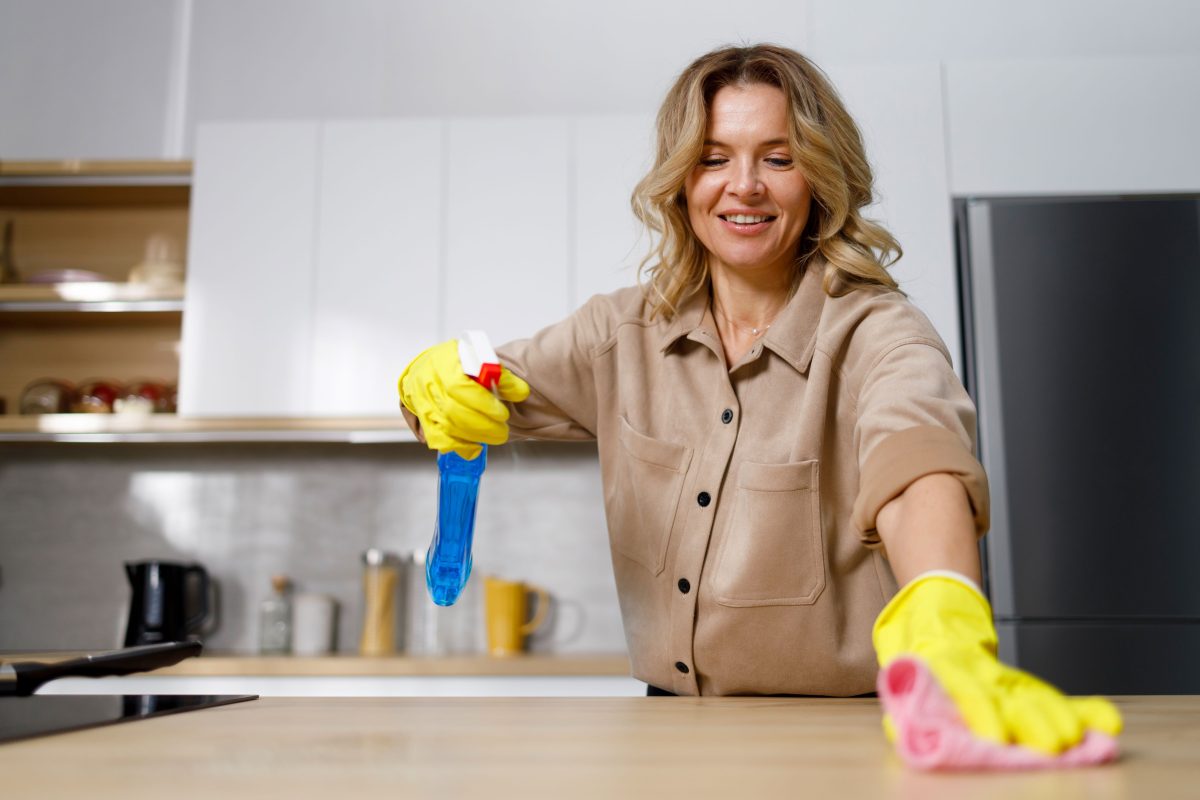Comprehending the Need for Completely Disinfecting and Disinfecting Regularly Touched Surfaces in High-Traffic Locations
In the realm of public wellness and security, the precise sanitation and sanitization of often touched surfaces in high-traffic locations stand as vital steps in protecting against the spread of damaging virus. By checking out the numerous elements of surface area disinfection, from the dangers associated with disregarding cleaning procedures to the reliable approaches that can be utilized, a more clear understanding arises of the essential function these practices play in guarding public wellness.
Importance of Surface Area Disinfection
Stressing the detailed sanitation of high-traffic surface areas is essential in preserving a sanitary environment and protecting against the spread of harmful virus. High-touch surfaces such as door handles, light switches, elevator switches, and countertops act as breeding premises for infections and bacteria. Regular disinfection of these surfaces is essential to minimize the risk of contamination and transmission of diseases.
By executing a durable sanitation method, services and organizations can develop a more secure atmosphere for consumers, workers, and site visitors. Correct surface disinfection not only alleviates the spread of contagious illness yet also infuses self-confidence in the sanitation and safety of the premises. This positive method shows a dedication to health and wellness and health, which is specifically vital in high-traffic locations where the chance of direct exposure to virus is increased.
Furthermore, surface sanitation plays an important function in total infection control approaches. Integrated with hand hygiene practices, using masks, and keeping physical distancing, thorough disinfection of high-touch surface areas forms a detailed defense against the transmission of damaging bacteria. Focusing on surface area sanitation is an essential component of a holistic strategy to health and safety in common rooms.
Dangers of Ignoring Cleansing Practices
Overlooking comprehensive disinfection of high-traffic surfaces substantially enhances the threat of viral and microbial contamination, positioning a serious threat to the health and wellness of individuals frequenting these spaces. Failing to carry out appropriate cleansing techniques can cause the accumulation and spread of unsafe pathogens, consisting of microorganisms and viruses, on frequently touched surface areas such as doorknobs, handrails, elevator buttons, and counter tops.

Additionally, neglecting the importance of comprehensive cleaning not only compromises the well-being of individuals but likewise weakens efforts to maintain a sanitary and tidy setting. It is important to identify the value of proper disinfection methods in protecting against the spread of infections and safeguarding public health.
Reliable Disinfection Methods
To preserve optimum sanitation and minimize the risk of contamination on high-traffic surface areas, employing reliable sanitation methods is vital. One of one of the most typical and reliable disinfection methods is making use of chemical disinfectants. These items can differ in toughness and structure, with some targeting details pathogens like viruses or microorganisms. It is important to follow the supplier's guidelines for appropriate dilution, call time, and air flow when making use of chemical disinfectants to guarantee their efficiency - Vacuum Carpets.
An additional effective technique is using UV-C light. UV-C light has been revealed to be reliable in eliminating a broad range of microorganisms by interrupting their DNA structure, therefore preventing them from reproducing. It is necessary to utilize UV-C light properly, guaranteeing that the correct intensity and exposure time are applied to accomplish the wanted disinfection outcomes.
Additionally, utilizing steam cleaning as a disinfection technique can be highly effective, specifically on surfaces that are heat-resistant. Heavy steam can permeate porous surfaces and kill bacteria, infections, and various other microorganisms properly. When making use of heavy steam cleaning, it is crucial to make sure that the surface area gets to the called for temperature level for an adequate quantity of time to ensure correct disinfection.
Effect On Public Health
The maintenance of high standards of tidiness and disinfection on high-traffic surfaces plays a critical duty in guarding public health and wellness. Often touched surface areas in areas with high tramp, such as doorknobs, hand rails, lift switches, and washroom facilities, offer as breeding grounds for harmful virus. Failing to appropriately sanitize these surface areas can lead to the quick spread of infectious click for source illness within neighborhoods. By implementing detailed sanitation procedures, the risk of transmission of viruses, microorganisms, and other bacteria can be dramatically reduced.
Effective sanitation techniques not just shield individuals from dropping ill yet also add to the total well-being of society. Public health and wellness authorities stress the relevance of keeping tidy settings to avoid break outs and consist of the spread of ailments. In high-traffic areas like airports, schools, hospitals, and mass transit systems, the impact of rigorous disinfection measures can not be underrated. Prioritizing the sanitization of often touched surface areas is a positive technique to advertising public health and wellness and enhancing the safety and security of individuals in shared spaces.
Executing Regular Cleansing Procedures
Promptly setting up and sticking to a constant routine of cleaning protocols is critical for keeping the sanitation and safety of high-traffic surface areas. Routine cleansing methods are necessary in stopping the accumulation of bacteria and microorganisms on often touched surface areas, especially in locations with high foot traffic. By implementing a methodical technique to cleansing, organizations can effectively lower the threat of illness transmission and create a much healthier atmosphere for workers, customers, and the public.
To develop a reliable cleansing schedule, it is vital to identify high-traffic areas that call for constant attention. These locations might consist of doorknobs, hand rails, elevator buttons, bathroom centers, and shared tools. Executing a routine cleaning regimen that targets these surface areas several times a day can dramatically decrease the spread of hazardous bacteria and infections.
Furthermore, using suitable cleaner and anti-bacterials is crucial to ensuring that surfaces are thoroughly sanitized. Routine training of cleansing staff on proper cleaning strategies and the importance of adherence click to find out more to the cleaning routine is also essential in maintaining a sanitary setting. By focusing on regular cleansing protocols, companies can promote the wellness and health of people that communicate with these high-traffic surfaces.

Final Thought
In verdict, it is crucial to focus on detailed disinfection and sanitization of frequently touched surface areas in high-traffic locations to stop the spread of harmful pathogens and keep public health. It is imperative to acknowledge the significance of keeping clean surfaces in high-traffic locations to guarantee the health of the community.
In the world article source of public wellness and safety, the thorough disinfection and sanitization of frequently touched surfaces in high-traffic locations stand as vital procedures in preventing the spread of unsafe microorganisms. By exploring the different elements of surface area disinfection, from the dangers connected with neglecting cleansing procedures to the efficient techniques that can be employed, a more clear understanding arises of the essential function these practices play in guarding public wellness.Furthermore, using steam cleansing as a sanitation technique can be very reliable, particularly on surface areas that are heat-resistant. When making use of heavy steam cleansing, it is essential to guarantee that the surface reaches the called for temperature for an enough quantity of time to guarantee proper sanitation.
In conclusion, it is crucial to focus on complete sanitation and sanitization of regularly touched surface areas in high-traffic locations to stop the spread of dangerous virus and preserve public health and wellness.